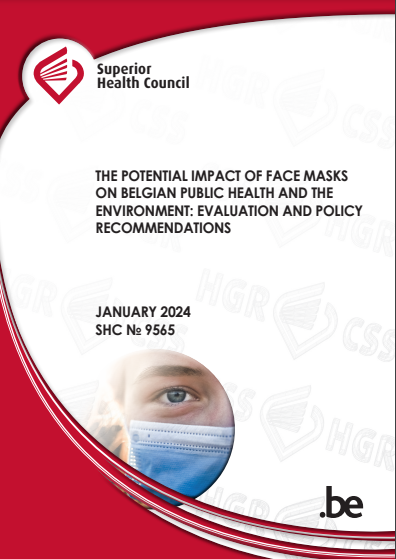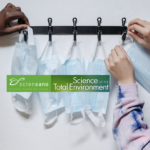
Nanos in masks: what does the Belgian Health Council recommend?
In a report on the impact of masks on health and the environment, the Belgian Health Council (SHC) judges the added-value of nanosilver to be limited, the use of titanium dioxide too risky, and knowledge of nano-plastics too limited. More generally, it calls for more research regarding nanomaterials.
After numerous publications on the presence and risks of nanos in masks, it’s now the turn of Belgium’s Superior Health Council (SHC) to publish a new contribution, in the form of an enlightening report on the impact of face masks on Belgian public health and the environment. Most of its major findings concern nanomaterials1traces of other harmful substances have also been found, but their level is generally very limited and below health standards:

Nano-silver is of no interest in consumer masks
Silver is often added to mouth masks – in ionic, metallic or nanoparticle form – to kill microbes and viruses.
According to the SHC, the amount of silver inhaled by users is generally below critical values in terms of adverse health effects, although exceptions are possible depending on mask models. Given the excellent physical filtering performance of many masks, the value of using silver is considered limited for masks intended for the general population: it could therefore be reserved for healthcare professionals with high exposure to pathogens. However, the report notes that “there is no indication on how much silver is needed in face masks for optimal antibacterial activity” and that, “since information is lacking, no guidelines for optimal concentration (per gram, cm² textile or any comparable unit) can be given”.
And what about the effects on ecosystems? While an entire paragraph is devoted to the environmental effects of masks (page 23) and in spite of the fact that “endocrine disrupting effects are possible in humans and wild life due to the presence of chemicals”, the report does not mention the specific risk of nano-silver on aquatic fauna, which is yet potentially high.
TiO2 should be banned from disposable masks
Masks often contain titanium dioxide (TiO2) as a whitening agent. (The Laboratoire Interdisciplinaire des Environnements Continentaux (LIEC) at the University of Lorraine has recently recently highlighted the risk of release of TiO2 nanoparticles when masks are degraded by UV rays, leading to increased mortality in aquatic crustaceans2Cf. Photodegradation of disposable polypropylene face masks: Physicochemical properties of debris and implications for the toxicity of mask-carried river biofilms, Bihannic I et al., Journal of Hazardous Materials, 465, March 2024). In view of its potential health risks – cancer risks in particular – the SHC recommends banning TiO2 in disposable masks based on the precautionary principle. In some disposable masks tested for 4-hour use by the Belgian Sciensano Institute, the dose of TiO2 likely to be inhaled is 10 times higher than the acceptable exposure level.
More research is needed on micro- and nanoplastics in masks
The SHC points out that wearing masks increases exposure to micro- and nanoplastics, but that an unquestionable extrapolation on the alteration of human health is not possible at present due to the lack of reliable experimental data. Further research is therefore required.
The SHC therefore supports the Sciensano Institute’s recommendation to set up an independent reference laboratory for nanomaterials to pursue this research, and considers it desirable to broaden the subject to include the various aspects of nanomaterials in general.
→ AVICENN couldn’t have wished for anything better, and is also calling for such a laboratory to be set up in France, and for in-depth research to be carried out into the risks associated with exposure to nanos, which today are almost unfunded!
Masks are necessary, but with less environmental impact and greater transparency about their composition
In the final analysis, the SHC considers that the protection offered by masks during a pandemic far outweighs the potential health risks of intensive use. It even believes that the use of mouth masks has saved many lives, particularly at the start of the pandemic. Nevertheless, it recommends reducing the environmental impact of mouth mask use by investing in biodegradable mouth masks in the future, or by considering the recycling of mouth masks after use.
Nevertheless, the Council considers – and even concludes its report – that “the government should require manufacturers to be transparent about the (chemical) composition of their masks and ensure their safety with independent testing”.
[The reference to LIEC’s work was added on February 19].

Les prochains RDV nano

- Webconference for analysis laboratories, plant fertilizer manufacturers and distributors, public authorities…
- Moderated by David Krupka, nanotechnologies development manager at AFNOR Normalisation and Emilie Langlois-Bertrand, nantechnologies standardization project manager.
- In partnership with Armand Masion, CNRS Research Director, and Sandrine Mocoeur, Health, Safety, Environment and Quality Manager at SYNGENTA.
- This exchange will also be an opportunity to explore the creation of a national platform to identify standardization needs.
- Website: www.afnor.org/evenement/nanotechnologies-agriculture-cadre-pratique-responsable/
- 8th Congress of Occupational Medicine and Health (CNMST 2026)
- Theme 5: Emerging pathologies and risks, Mr Henri Bastos (ANSES), Pr Lynda Bensefa-Colas (AP-HP), Dr Catherine Nisse (CHU Lille)
- Website: www.medecine-sante-travail.com
- 20th meeting of the “nano and health” dialogue committee
- Organizer: ANSES
Notes and references
- 1traces of other harmful substances have also been found, but their level is generally very limited and below health standards
- 2Cf. Photodegradation of disposable polypropylene face masks: Physicochemical properties of debris and implications for the toxicity of mask-carried river biofilms, Bihannic I et al., Journal of Hazardous Materials, 465, March 2024




